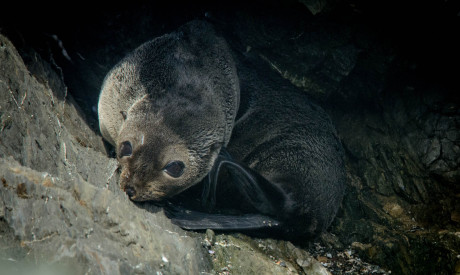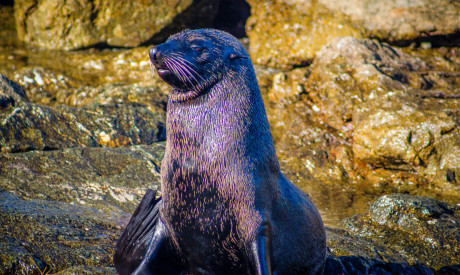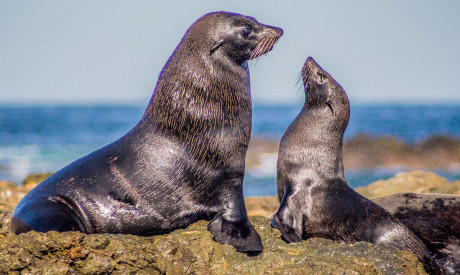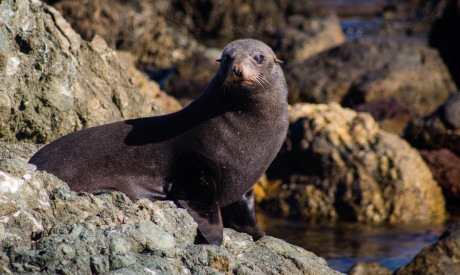
Juvenile and subadult Guadalupe fur seals along the northeast side of El Farallón de San Ignacio Island
(May and June 2020). Photo: Jorge Paul Orduño García.
Click on picture to expand
Guadalupe fur seals were hunted for their furs and declared extinct in the late 1800’s. However, 14 individuals were discovered on Guadalupe Island in 1950—and the population has grown since then. While still vulnerable to extinction according to IUCN criteria, the population is believed to total about 41,000 individuals and is growing at an annual rate of 10-11 per cent per year.
While the only breeding site for this species continues to be on Guadalupe Island, a large resting colony or ‘haul-out’ was established in the late 1990s on the nearby San Benito Islands in the Pacific Ocean, off the coast of Baja California.
Now, a second, well-populated haul-out colony has also begun forming, this time off the Mexican coast in the Gulf of California.

The east and north sides of El Farallón de San Ignacio Island (Sinaloa, Mexico). The seine boat passing in front of one of the steep rocky haul-outs used by Guadalupe fur seals participates in the sardine fishery. Photo:
Jorge Paul Orduño García.
Click on picture to expand
“We at first thought that the animal sighted in 2008 was an anomaly,” said Andrew Trites, professor in the Marine Mammal Research Unit, based in UBC’s Institute for the Oceans and Fisheries, and co-author of the research findings. “El Farallón is a small, hot and arid island, and not a place where anyone would have expected to find fur seals. However, the past six years of observation have shown that the young Guadalupe fur seals clearly like it. The question is why?”
Trites and Hernández-Camacho suspect this new haul-out is centered in a new seasonal feeding area used by young Guadalupe fur seals. Guadalupe fur seals are known to feed mainly on opalescent squid, Humboldt squid and purpleback squid.
In addition to the new colony discovered at El Farallón de San Ignacio Island, a smaller haul-out also in the southern Gulf of California has also been growing since 2019 on nearby Las Animas Islet.
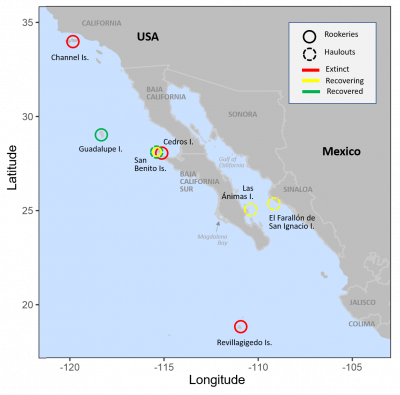
Current and historical distribution of the Guadalupe fur seal based on historical records (Mexico) and
archeological data (from the California Channel Island and coast of California; Rick et al., 2009). Locations of known haul-outs (dashed circles) and rookeries (solid circles) of Guadalupe fur seals show those that are extinct (red), those that appear to be recovering (yellow), and those that have recovered (green).
Click on picture to expand
With the confirmed establishment of the El Farallón colony, it is important that Mexico develop a conservation policy that addresses the importance of the southern Gulf of California as a feeding ground for vulnerable Guadalupe fur seals.
Overall, Guadalupe fur seals are slowly increasing in the southern Gulf of California—and are known to range as far as the coastlines of Washington and British Columbia. However, they only spend time on land at just four places, which are all in Mexico.
“Guadalupe fur seals have only one breeding colony, so the new haul-outs in the southern Gulf of California provide some good news. However, the new sites will need regular monitoring to document their growth and possible changes in body conditions, age and sex-composition, and breeding potential”, said Trites.
“This species escaped extinction once and remains vulnerable.”
“New colony of Guadalupe fur seals (Arctocephalus townsendi) discovered on El Farallón de San Ignacio Island, Gulf of California” was published in Marine Mammal Science.
Tags:
